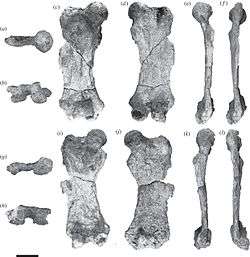Eionaletherium
| Eionaletherium Temporal range: Late Miocene | |
|---|---|
 | |
| Right and left femurs | |
| Scientific classification | |
| Kingdom: | Animalia |
| Phylum: | Chordata |
| Class: | Mammalia |
| Superorder: | Xenarthra |
| Order: | Pilosa |
| Family: | †Mylodontidae |
| Genus: | †Eionaletherium Rincón et al., 2015 |
| Type species | |
| †Eionaletherium tanycnemius Rincón et al., 2015 | |
Eionaletherium (Greek, "shore wanderer beast") is a extinct genus of ground sloth of the family Mylodontidae endemic to the Venezuela region of South America during the Late Miocene.[1]
Like the semiaquatic genus Thalassocnus, Eionaletherium had an elongated tibia. However, since the bones do not exhibit pachyostosis, a hardening of the bones typical in aquatic animals, including Thalassocnus, the animal is believed to have been terrestrial.[2][3]
Discovery and etymology
The holotype bones of Eionaletherium - femurs, tibias, vertebrae, scapulae, astragalus and rib fragments - were discovered in the Urumaco Formation of Venezuela.[4][2] The relevant area of the formation had previously only yielded fossils of turtles and crocodiles.[2]
The genus name Eionaletherium comes from the Greek words eion (shore), ale (wanderer), and therium (beast), in reference to the palaeoenvironment of the Urumaco Formation. The species name tanycnemius comes from the Greek for "long leg". was described and named by Ascanio D. Rincón.[2]
See also
References
- ↑ "Descubren extraño fósil de perezoso gigante en desierto de Falcón". Bitacora.
- 1 2 3 4 Rincón, A. D.; McDonald, H. G.; Solórzano, A.; Flores, M. N.; Ruiz-Ramoni, D. (2015). "A new enigmatic Late Miocene mylodontoid sloth from northern South America". Royal Society Open Science. 2 (2). doi:10.1098/rsos.140256.
- ↑ "Descubren extraño fósil de perezoso gigante en desierto de Falcón". Panorama
- ↑ "Giant extinct 'beach-walking' sloth species discovered in Venezuela". International Business Times, Hannah Osborne, February 27, 2015.